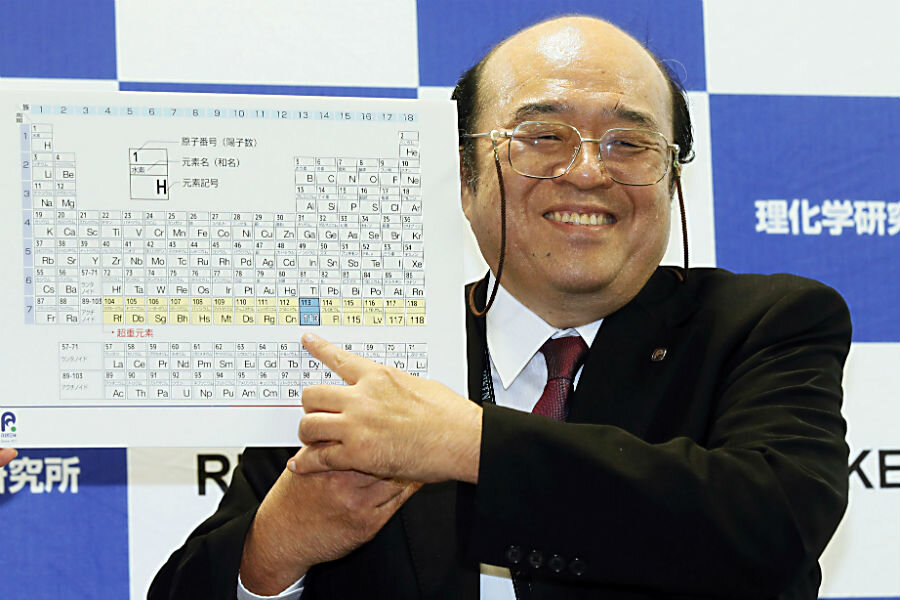Name game: What to call the periodic table's four newest elements?
Loading...
What's in a name?
When the four new elements just added to the periodic table get official names, don't expect Unobtanium or T.Lehreronium to emerge.
Naming new chemical elements is a super-serious business.
Biologists have the leeway to honor cartoon character SpongeBob SquarePants by naming a Hawaiian mushroom, Spongiforma squarepantsii. But don't expect a new element to be named after Harvard mathematician Tom Lehrer, writer of the beloved Element Song.
The four new substances are in the transfermium category, having an atomic number higher than fermium, which is element 100.
They are the first to be added to the table since 2011 and are currently known as 113, 115, 117 and 118. The new elements were verified on Dec. 30, 2015 by a team formed from the International Union of Pure and Applied Chemistry (IUPAC) and the International Union of Pure and Applied Physics (IUAPAP). They've been given temporary names – ununtrium (113), ununpentium (115), ununseptium (117) and ununoctium (118) – before their discoverers assign permanent replacements.
All four are artificially made "superheavy elements," that break down quickly into lighter substances. The creators of element 113 are the RIKEN team in Japan. Element 118 was a collaboration between the Joint Institute for Nuclear Research in Dubna, Russia, and the Lawrence Livermore National Laboratory in California. The remaining elements were created by the Oak Ridge National Laboratory in Tennessee for the discovery of elements 115 and 117.
Social media immediately weighed in.
“I always tell my students that in biology you've got to watch out because we will name something after just about anything you can dream of,” says Arthur Bowman, a biology professor at Norfolk State University in Virginia. “In 1977, Arnold Menke named a wasp the Aha ha – after what we say when we find something new.”
While IUPAC rules allow elements to be named after a mythological concept, a mineral, a place or country, a property, or a scientist, Janan Hayes, professor emeritus at Merced College in Merced, Calif., says in an interview that it is highly unlikely that anything non-traditional will be chosen.
“Naming an element isn’t what it used to be,” says Dr. Hayes, former chair of the American Chemical Society’s Division of History of Chemistry and a previous liaison to the ACS Committee on Nomenclature during the time period when the current IUPAC procedures for naming transfermium elements were developed.
“It used to be that when a discovery was made, when you thought you had one, you named it something,” Hayes says. “But this was very confusing because you could end up with three or four names for an element as three or four different groups or laboratories claimed discovery. What makes the naming important internationally is that the name is accepted internationally.”
Things got serious during the "Transfermium Wars" which reached a fever pitch in a Cold War-era standoff during the 1960s between the US and Russia when both nations laid claim to the discoveries of elements 104 and 105 and IUPAC held the role of arbiter, Hayes explains.
“It took until 1997 to sort it out. Its decision resulted in ... some very specific rules,” she says. “I don’t think there will be a Transfirmium War this time around. World politics don’t usually get involved in science. These scientists are friends. They’re in and out of each other’s labs in cooperation.”
In the end, Americans named element 104 Rutherfordium, in honor of British chemist and physicist Ernest Rutherford. Element 105, Dubnium, is named for the Russian town of Dubna.
Still, citizen scientist and candy maker Gregory Cohen, who owns the candy shop Public Displays of Confection and is also the creator of a Tom Lehrer fan site, is not giving up hope.
“Lehronium is good, but I think ironic-ite is better,” writes Mr. Cohen in an e-mail exchange. “I think a truly unstable material would be suitable, as instability matches Mr. Lehrer’s career well.”
Cohen adds, “This would be a great tribute, better than a stamp. In any case, if it does happen, a celebration must happen when the news of it comes to Harvard.”
Asked if Lehrer has a chance at being honored with a new element name, Dr. Hayes says, “That’s just not gonna happen. That’s popular science and how we learn the names.”
“This is like naming your children, you choose a family name that has deep meaning to them,” she says. “Biologists get to do all those sorts of things, more whimsical namings, because they have so much more to work with. In chemistry, we have so little that we really need to put deeper thought into it every time.”








